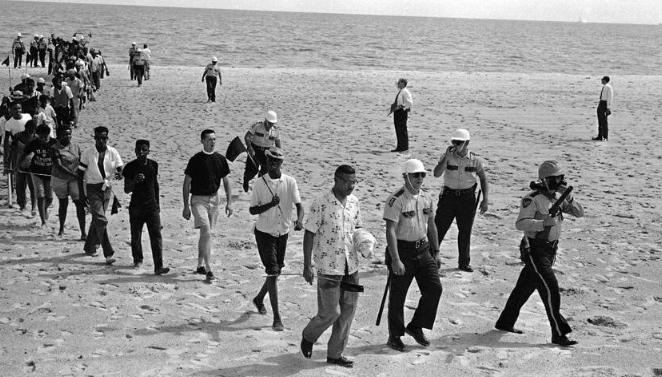Biloxi Wade-Ins: Breaking the Racial Barrier on Mississippi Beaches

Introduction
A series of nonviolent demonstrations known as the Biloxi Wade-Ins were crucial to the civil rights movement in the 1950s and 1960s. These wade-ins, which were aimed at desegregating Biloxi, Mississippi’s beaches, were crucial in opposing racial prejudice and segregation in the American South. The history, significant individuals, and long-lasting effects of the Biloxi Wade-Ins on the struggle for racial equality are examined in this article.
Background
The Mississippi Gulf Coast city of Biloxi served as a symbol of the systemic racial segregation and prejudice that prevailed in the American South during the middle of the 20th century. African Americans in this seaside community had to adhere to rigorous segregation, especially on public beaches. Access to the beach was generally restricted for white residents, while African Americans were systematically prohibited from enjoying the same public spaces and services.
The Protagonists: Gilbert R. Mason Sr. and the Youth Council
The eminent doctor and civil rights advocate Dr. Gilbert R. Mason Sr. played a significant role in the Biloxi Wade-Ins. Due to his personal and professional encounters with racial discrimination and segregation, Dr. Mason has actively promoted civil rights in his neighborhood. He established the Biloxi Civic and Benevolent Association in the early 1950s to address issues affecting the African-American community.
The National Association for the Advancement of Colored People’s (NAACP) branch Biloxi Youth Council was instrumental in planning and supporting the wade-ins. The Youth Council, which was made up of young activists, was unafraid to stand out against racial segregation in Biloxi.
The Wade-Ins Begin
When a group of African American activists, led by Dr. Mason and the Youth Council, decided to protest the prejudiced beach rules, the Biloxi Wade-Ins had their start in 1959. African American beachgoers attempted to enter the “whites only” public beaches on May 14, 1959. Hostility, assault, and arrest were used against them. White nationalist organizations and the police collaborated to perpetuate segregation through violence and intimidation.
The demonstrators remained unwavering despite the threat they were in. They persisted in staging wade-ins, garnering support and attention on a national scale. Despite being aware of the dangers, the campaigners remained dedicated to securing equitable access to the beaches.
Challenges and Resistance
White nationalists and municipal officials reacted angrily to the Biloxi Wade-Ins. The demonstrators were subjected to vicious assaults, intimidation, and arrests. They persisted in their commitment to nonviolent resistance in the face of such hostility, motivated by the ideas of moral persuasion and civil disobedience.
The wade-in pressure and the negative headlines it produced started to have an effect. The demonstrations brought racial segregation’s injustices to light and inspired leaders and groups dedicated to civil rights across the nation.
Landmark Legal Victory
The campaigners’ perseverance and sacrifice eventually paid off. The Mississippi Supreme Court held in Herod v. City of Biloxi in 1960 that everyone should have access to the beaches, regardless of race. The decision was a major judicial win and a turning point in Biloxi’s struggle against racial segregation. The campaigners’ tenacity and fortitude had caused a noticeable shift in the legal system.
Read also The Ultimate Strategy: White Label Facebook Advertising
The Legacy of the Biloxi Wade-Ins
An enduring legacy was left by the Biloxi Wade-Ins, both locally and internationally. They significantly influenced the larger civil rights movement:
Legal Precedent: The legal victory in the Herod case established a standard for opposing segregation in public places throughout the South, not just in Mississippi.
Inspiration for Future Activists: Other civil rights advocates were inspired by the Biloxi Wade-Ins to fight racial discrimination in a variety of contexts, including lunch counters and public transit.
The Power of Nonviolent Resistance: The Wade-ins highlighted the moral high ground held by civil rights activists by demonstrating the effectiveness of nonviolent resistance in the face of violence and intimidation.
National Attention: The wade-ins inspired support from civil rights organizations and leaders and brought attention to the South’s struggle for civil rights on a national scale.
Conclusion
The Biloxi Wade-Ins were a brave and crucial campaign in the struggle for civil rights in the United States, led by Gilbert R. Mason Sr. and the Biloxi Youth Council. Although the activists were subject to abuse, teasing, and detention, they persisted in their adherence to the values of nonviolent resistance and civil disobedience. The Wade-ins inspired other activists and brought attention to the ongoing struggle for racial equality, and their efforts resulted in a significant judicial victory.
The Biloxi Wade-Ins serve as a reminder of the lasting strength of nonviolent resistance as well as the potential of grassroots activism to confront systematic racism and segregation. They serve as a tribute to the fortitude and tenacity of people who were prepared to jeopardize their safety in the pursuit of justice and equality. The struggle for civil rights is still going on, and the lessons learned during the Biloxi Wade-Ins are still applicable to the current fight for racial justice in the US.




